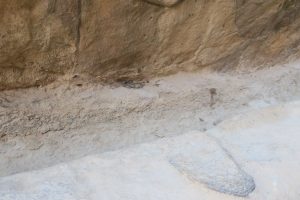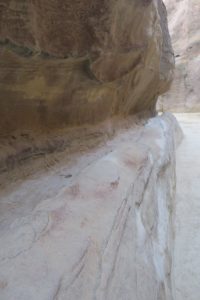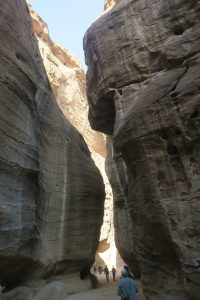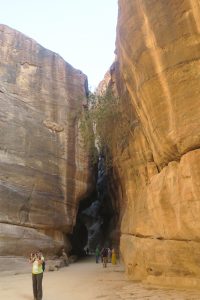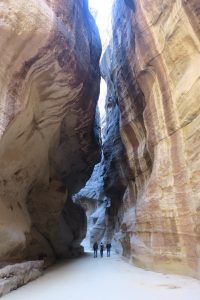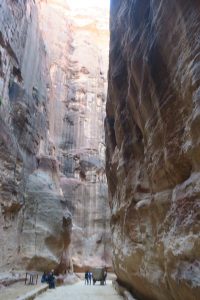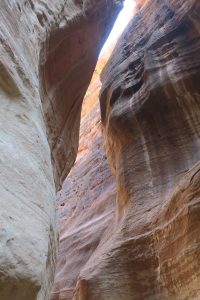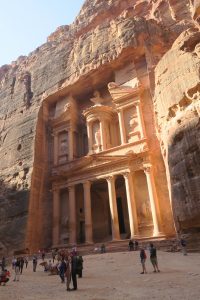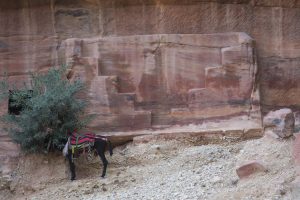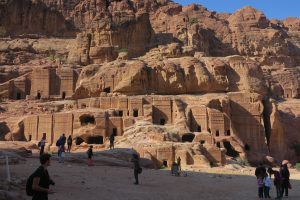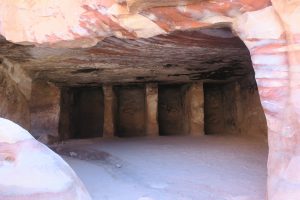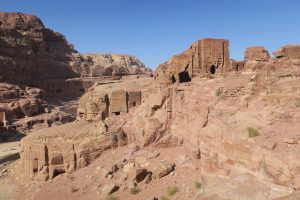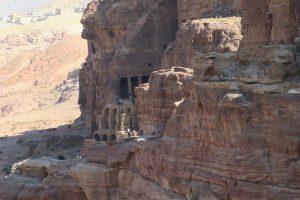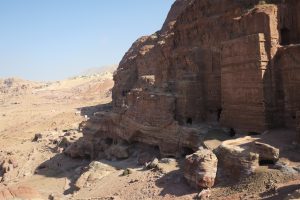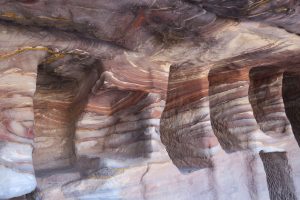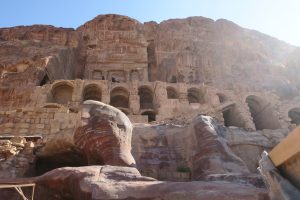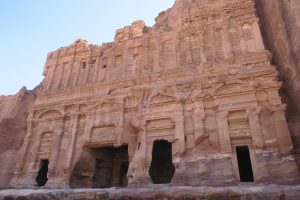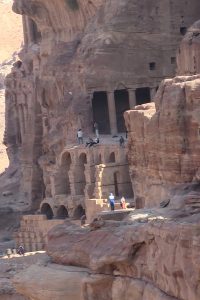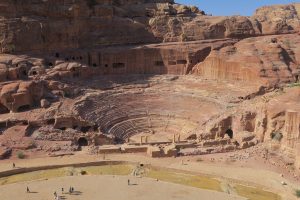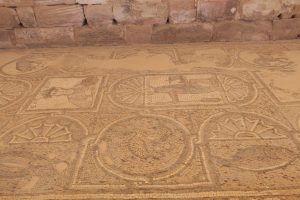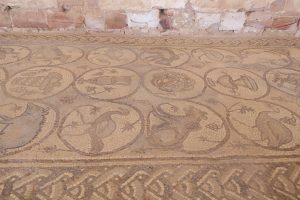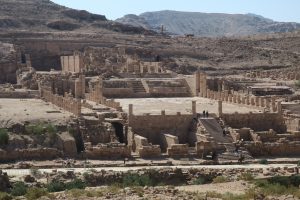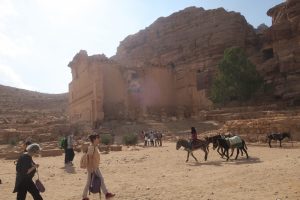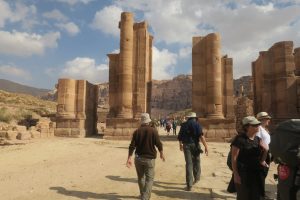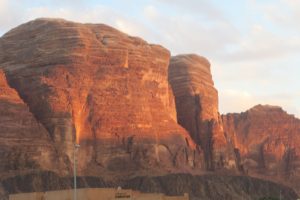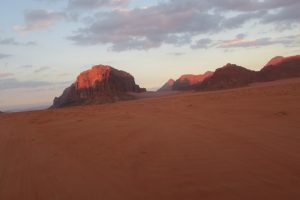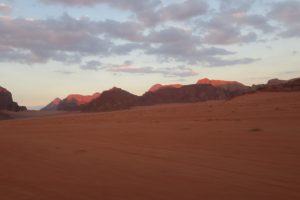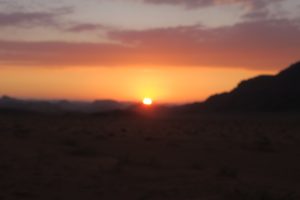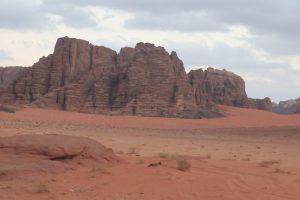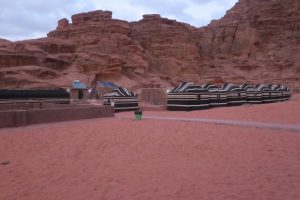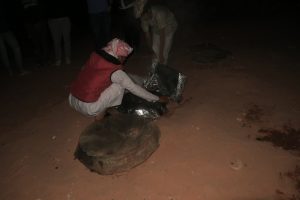We were very excited today because we were going to Petra, definitely one of the highlights of the trip. Petra is believed to have been settled as early as 9,000 BC, and it was possibly established in the 4th century BC as the capital city of the Nabataean Kingdom. The Nabataeans were nomadic Arabs who took advantage of Petra’s proximity to the trade routes and established it as a major regional trading hub. Most caravans could not make the entire journey between Africa and Europe or Asia, so Petra became a caravan meeting/resting place where goods could be exchanged for the journey to their destination.
The trading business gained the Nabataeans considerable revenue and Petra became the focus of their wealth. They were particularly skillful in harvesting rainwater, developing agriculture and carving stone. The area is visited by flash floods, and archaeological evidence demonstrates the Nabataeans controlled these floods by the use of dams, cisterns and water conduits. These innovations stored water for prolonged periods of drought and enabled the city to prosper from its sale of water. Petra was at its peak from about 200 BC to about 200 AD.
Petra is approached through a very dramatic, narrow rock corridor called “The Siq.” They had water channels running along the side of the corridor that were at a 2% grade, the optimal grade to keep the water moving freely. Periodically there were deeper pits which functioned as filters. Here are some pictures of the siq.
Most of what is left today are tombs. The wealthier members of society created bigger and more impressive tombs, craved into the mountain sides. In the larger tombs one level was for the tomb and a second level was a funerary hall. It varies which was the first floor and which was the second floor. The people lived on the hills in free standing homes which have been reduced to rumble. We walked/climbed around and into some of the tombs. The carving on the tombs was amazing. They carved from the top down to remove any evidence of the scaffolding they used. Not only were the tombs beautiful, but the rock itself was amazing. The most famous tomb is called the Treasury because at one time is was believed to be a treasury. Today it is believed to be a tomb.
There was an amphitheater as well as some later period temples and churches with beautiful mosaic floors.
We hiked up to the Monastery which was a tomb that had been converted into a monastery. We ran into Ben and Vivien on our way up. We saw them several more times at Petra. They are really nice people. We hoped our paths would cross again.
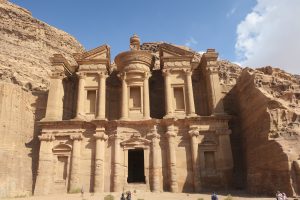 After resting a bit at the cafe in front of the Monastery we walked about 1 1/2 hours back to the car. We walked almost 11 miles that day. We planned to spend the night in a Bedouin camp in Wadi Rum and wanted to watch the sunset from there. We made it to the transfer site just in time. We loaded our suitcases into a pickup truck and climbed into the back. We had a wild ride (translation: very fast) to the camp, but made it just in time for the sunset.
After resting a bit at the cafe in front of the Monastery we walked about 1 1/2 hours back to the car. We walked almost 11 miles that day. We planned to spend the night in a Bedouin camp in Wadi Rum and wanted to watch the sunset from there. We made it to the transfer site just in time. We loaded our suitcases into a pickup truck and climbed into the back. We had a wild ride (translation: very fast) to the camp, but made it just in time for the sunset.
We are staying in tents which are pretty basic.
That night we had a Bedouin meal which consisted of chicken and vegetables that were cooked in a pit in the sand. It was very good.
We went to bed early because we were tried from all the walking and we want to get up early for the sunrise.

